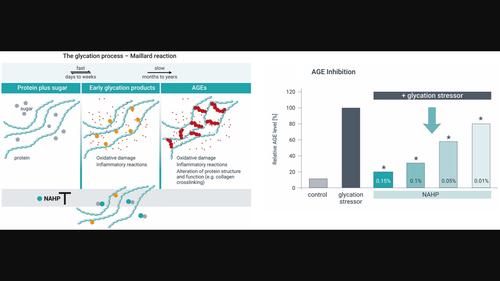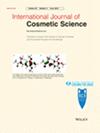N-acetyl-L-hydroxyproline – A potent skin anti-ageing active preventing advanced glycation end-product formation in vitro and ex vivo
Abstract
Objective
Advanced glycation end-products (AGEs) represent a large group of compounds generated by a non-enzymatic reaction between reducing sugars and amino groups. The formation and accumulation of AGEs in the skin lead to protein crosslinking, dermal stiffening and yellowing, which ultimately contribute to cutaneous ageing. Amino acids have been described to exhibit anti-glycation effects. The objective of this study was to understand the inhibitory role of the amino acid derivative N-acetyl-L-hydroxyproline (NAHP) as an anti-glycation active for human skin.
Methods
A cell-free assay investigating the inhibition of glycation of serum albumin by NAHP was used to determine the capability of NAHP to decrease AGE formation. Also, by assessing the amount of the AGE N-(carboxymethyl)lysine (CML) the anti-glycation abilities of NAHP were investigated utilizing dot blot analysis. The improvement of cell–matrix interaction by NAHP was determined in vitro using a glycated fibroblast-populated collagen lattice (FPCL) dermis model. In skin biopsies, AGE autofluorescence was determined after treatment with NAHP and/or glucose ex vivo.
Results
NAHP significantly and dose-dependently inhibited levels of AGEs, which were induced by the glycation of a protein solution. This decrease could be visualized by showing that the brownish appearance as well as the AGE-specific fluorescence of glucose-treated samples were reduced after the application of increasing amounts of NAHP. Also, CML formation was dose-dependently inhibited by NAHP. In FPCLs, the contractile capacity of fibroblasts was significantly disturbed after glycation. This could be prevented by the addition of NAHP. Compared to glyoxal-treated samples, the co-application of NAHP significantly decreased the diameter as well as the weight of glycated FPCLs. Ex vivo application of glucose to skin explants showed a higher AGE fluorescence signal compared to control explants. Co-treatment with NAHP and glucose decreased the level of AGE fluorescence in comparison to glucose-treated explants.
Conclusion
These data provide clear evidence that under glycation stress conditions treatment with NAHP inhibited AGE formation in vitro and ex vivo and prevented the loss of cellular contractile forces in a glycated dermis model. Thus, NAHP obviously provides a beneficial treatment option to counteract AGE-related changes in human skin such as dermal stiffening and yellowish skin appearance.



 求助内容:
求助内容: 应助结果提醒方式:
应助结果提醒方式:


